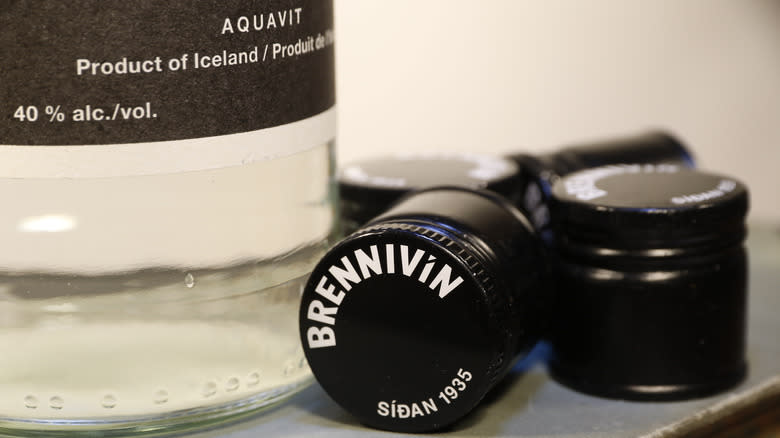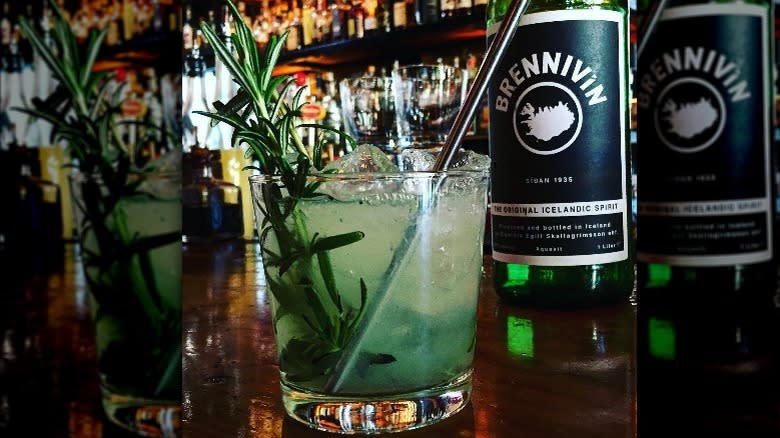Black Death: Here's How Iceland's National Drink Got Its Forbidding Nickname

It's not black and it's unlikely to kill you. Well, at least as long as you're imbibing responsibly. So, what's the deal with Black Death, Iceland's national adult beverage? And why does it have such a haunting moniker? Let's tackle the nickname first. Officially, Black Death is known as brennivín. It's a clear, distilled spirit that's traditionally derived from fermented potato mash and infused with spices like caraway and cumin. At its core, brennivín is the Icelandic version of a Nordic aquavit, a distilled beverage similar to vodka.
Roughly translated, "brennivín" means "burned wine," a nod to the fact that it's distilled over an open flame. Interesting for sure, but still a long way from explaining the spirit's ominous name. As it turns out, the term Black Death has absolutely nothing to do with the drink itself. Instead, it's a reference to the original brennivín label, which was a solid black panel adorned with a skull and crossbones. According to legend, the design was intended to convey a not-so-subtle drink-at-your-own-risk message to potential imbibers.
The plan backfired. Instead of seeing it as a warning, drinkers took it as a challenge, giving the harsh liquor an almost iconic status. Eventually, a map of Iceland replaced the skull and crossbones on the label, but the spirit inside the bottle still packs a punch, clocking in at 37.5% alcohol by volume. Which brings to mind a second theory about the genesis of its nickname: Rumor has it that the name Black Death may also be a reference to drinkers who pass out after over-imbibing.
Read more: 23 Cocktails To Try If You Like Drinking Gin
Brennivín Is An Unexpected Herbal Pleasure

Despite its powerful reputation, brennivín is a reasonably subtle spirit. Following a blind tasting in 2016, Kara Newman, a columnist for Wine Enthusiast, described the spirit as "nuanced and palate-cleansing," adding, "Look for a mild, savory scent and bracing notes of dill, fennel seed, and pine, plus a brisk, zingy finish that suggests caraway-seeded rye bread. Pair this refreshing sip with herring or other savory bites."
More recently in 2023, Király Lazos, a bartender at Reykjavik's Jörgensen Kitchen & Bar, told Food & Wine that brennivín can be an acquired taste. "First, you'll taste the cumin, then for a second, you'll have a tasteless moment, then the caraway will come in, and the sweetness will tie it all in. It will be quite strong. All of these flavors you would associate with food, not drinks. That's why it's off-putting for most people because it will be very strange." Off-putting? Maybe, but brennivín has a growing fan base due, at least in part, to the craft cocktail movement.
Traditionally served well-chilled in an icy shot glass, the spirit known as Black Death is gaining momentum as the main ingredient in more refined cocktails. It's a challenge creative bartenders are more than willing to accept. With its caraway-forward essence, it's an interesting substitute for rye whiskey and, due to its herbal essence, brennivín can also pinch hit for gin and light rum. For a new twist on an old classic, consider blending brennivín with fresh orange juice, bitters, and club soda. Garnish with a sprig of rosemary and -- voilà! A Black Death screwdriver.
Read the original article on Tasting Table.

